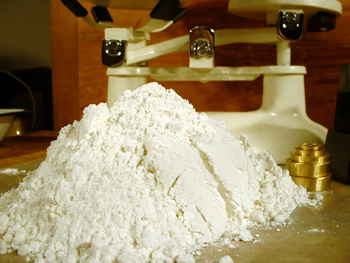
Cake Flour. © Denzil Green
Cake flour is wheat flour milled from soft (lower protein) wheat. It has a lower gluten content than pastry flour, and a far lower gluten content than bread flour. Cakes need to be light and fluffy and have a very fine texture, thus you don’t want a lot of gluten developing in the batter.
In production, the flour has at first a pale beige or yellowish colour. This is then lightened by bleaching it with chlorine.
The chlorine makes the flour slightly acidic, which makes the flour better able to absorb water, and enhances the ability of sugar and fat molecules to stick to the flour. This has the overall effect of “strengthening” the flour, allowing it to support better the weight of the sugar and fat in a cake, resulting in an overall finer, more even texture.
Cake flour is usually pre-sifted (several times) before packaging, and sometimes, cornstarch is added.
Cake flour is usually sold in smaller quantities than other flour is.
Some people say that using cake flour instead of all-purpose flour tends to keep cookies from spreading on cookie sheets (its lower protein content ties up less moisture making it available for steam production. Steam lifts the batter in the oven producing a fluffy, cake-like batter.) Other people say cake flour is usually too tender for cookies, and advise you to just use all-purpose flour or plain flour unless otherwise instructed.
Substitutes
Pastry flour, cake & pastry flour, all-purpose flour (Canada); or per cup of cake flour two tablespoons of corn starch plus ⅞ cup of American all-purpose flour or British plain flour.
These are the step-by-step directions from the University of Arkansas Cooperative Extension Service:
“Step 1: Measure 1 cup all-purpose flour. Remove 2 Tablespoons.
Step 2: Measure 2 Tablespoons cornstarch. Add to the flour. Cornstarch contains less gluten than flour.
Step 3: Sift together TWICE. Sift into a mixing bowl once. Then run it through the sifter one more time. Sifting not only mixes the two ingredients together, it aerates the mixture, so the consistency is like real cake flour.
Step 4: Measure 1 cup from this mixture. You’ll have about 1 cup anyway, but sometimes sifting can produce more volume since it’s adding air.” [1]Due, Carla. What You Need to Know About Flour; Hint, It’s Not All the Same. University of Arkansas Cooperative Extension Service. Accessed January 2021 at https://www.uaex.edu/counties/miller/news/fcs/miscellaneous/What%20You%20Need%20to%20Know%20About%20Flour%20Hint%20Its%20Not%20All%20the%20Same.aspx
Equivalents
1 pound (450g) cake flour = 4 ½ cups
History Notes
Flour marked as “Cake Flour” was sold in the United States as early as the 1920’s.
References
| ↑1 | Due, Carla. What You Need to Know About Flour; Hint, It’s Not All the Same. University of Arkansas Cooperative Extension Service. Accessed January 2021 at https://www.uaex.edu/counties/miller/news/fcs/miscellaneous/What%20You%20Need%20to%20Know%20About%20Flour%20Hint%20Its%20Not%20All%20the%20Same.aspx |
|---|

